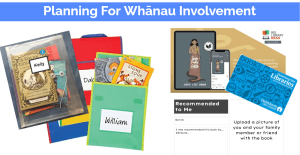The purpose of sharing creates connections that deepen our understanding through discussion. It is part of our survival and human instinct to share no matter the status in society. Kids love to share whether its with people they know or don’t know. This is a part of them that is strong to the core, so why not utilise it in our classroom space. The students in my space love to share their create with me, and to their friends. It’s something that I’m working on expanding throughout our collaborative hub.
An authentic audience creates authentic sharing and connection. This can be done in so many ways either peer assessment, class, school, local community or even go as far as the world. Sharing now is not limited to just face to face, students can now have a wider audience online through blogging sharing their mahi to the wider community and the world. This is something that I’m currently working on making it a routine in our timetable fortnightly for our tamariki to share their learning in their blog.
 Using a blog can also benefit teachers, it is a way to track their learning and can make some sort of affirmative assessment for the student’s blog. If the students do not have anything on their blog, this can also give you an indication of their starting point. Having students share their learning creates opportunities for students to reflect on their learning. Think about what they enjoyed and what they found challenging and know what they have learnt in that space. Blogging is also a record of learning, where teachers can use it for students to reflect on their learning. It shows the progress they have made from their previous blogs and now. When students are sharing their learning they can also give feedback, what they have achieved, what strategies they used to be successful in their learning, and feed forward to their possible next steps. Feedbacks can be given by their peers or by the teacher.
Using a blog can also benefit teachers, it is a way to track their learning and can make some sort of affirmative assessment for the student’s blog. If the students do not have anything on their blog, this can also give you an indication of their starting point. Having students share their learning creates opportunities for students to reflect on their learning. Think about what they enjoyed and what they found challenging and know what they have learnt in that space. Blogging is also a record of learning, where teachers can use it for students to reflect on their learning. It shows the progress they have made from their previous blogs and now. When students are sharing their learning they can also give feedback, what they have achieved, what strategies they used to be successful in their learning, and feed forward to their possible next steps. Feedbacks can be given by their peers or by the teacher.

A way to create an authentic audience and build reading communities is having whānau involved. Having students share their learning with their whānau from different subjects, what they have done in their books or online learning. This again will provide opportunities for children to reflect on their learning and share an even closer and deeper connection with their whanau as their audience when sharing their work. This is something that already happens in St Mary’s where students take charge of showing their learning, and progress they have made throughout the year.
Kia ora Ashley,
blogging is such a good way to share.
Jazz has some really good systems that might help you to keep blogging as a part of your reading programme. All of this builds an authentic audience.
The students that come to you have a basic understanding of blogging so with regular use they will increase their efficiency in blogging.
Making connections with whānau is so important and the way your school does it is very meaningful.
Having completed RPI I hope you have a whole lot more in your kete for your programme and you
are able to continue to use this valuable learning.
from Cheryl
HI Ashley, I like your comments about having an authentic audience and the ability to connect with whānau that sharing can enable. It’s great to see what you are doing in this space with your learners. I have enjoyed connecting with you during the RPI this year, I hope you found the sessions worthwhile and of benefit to your teaching. Hope to stay in touch. Kiri